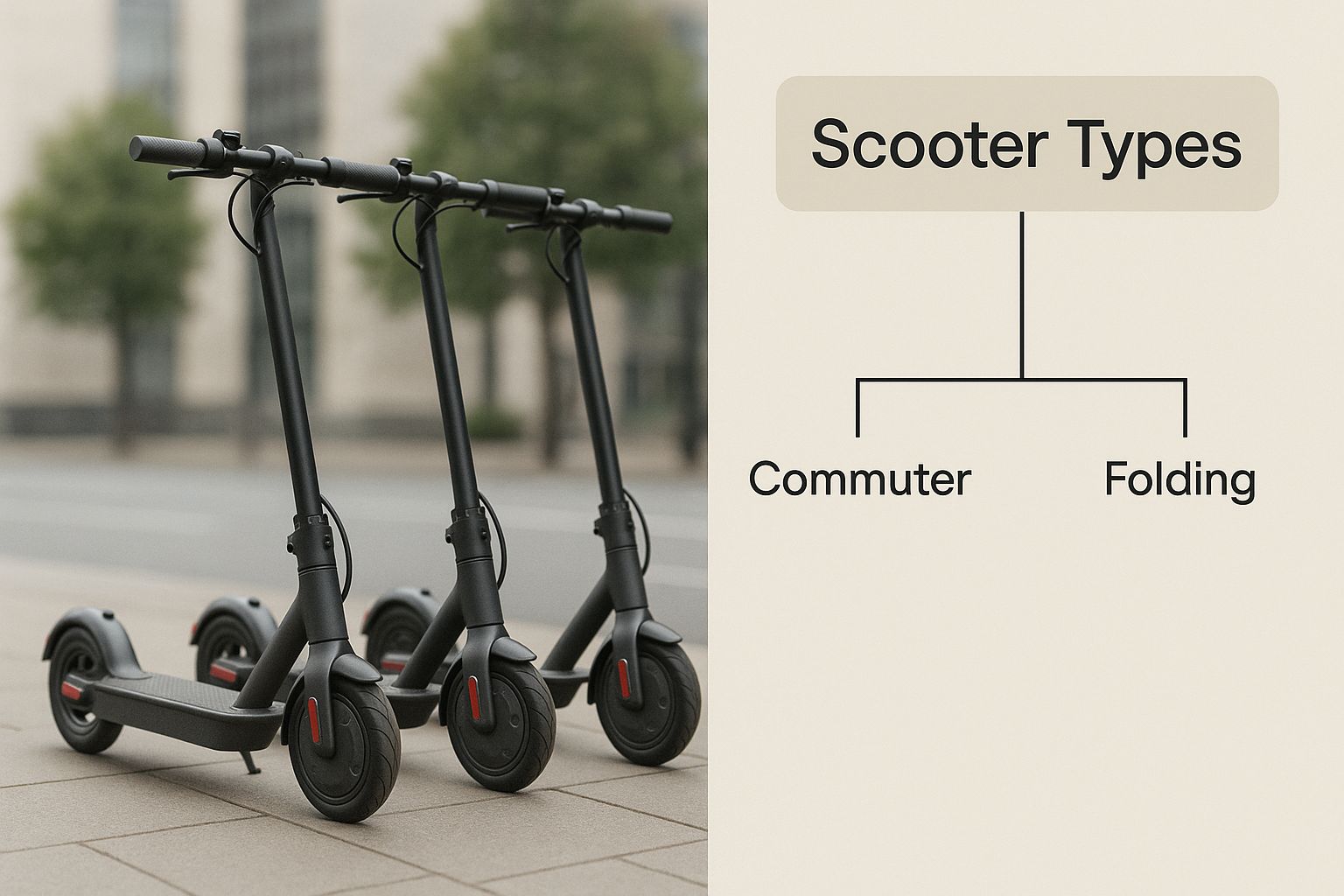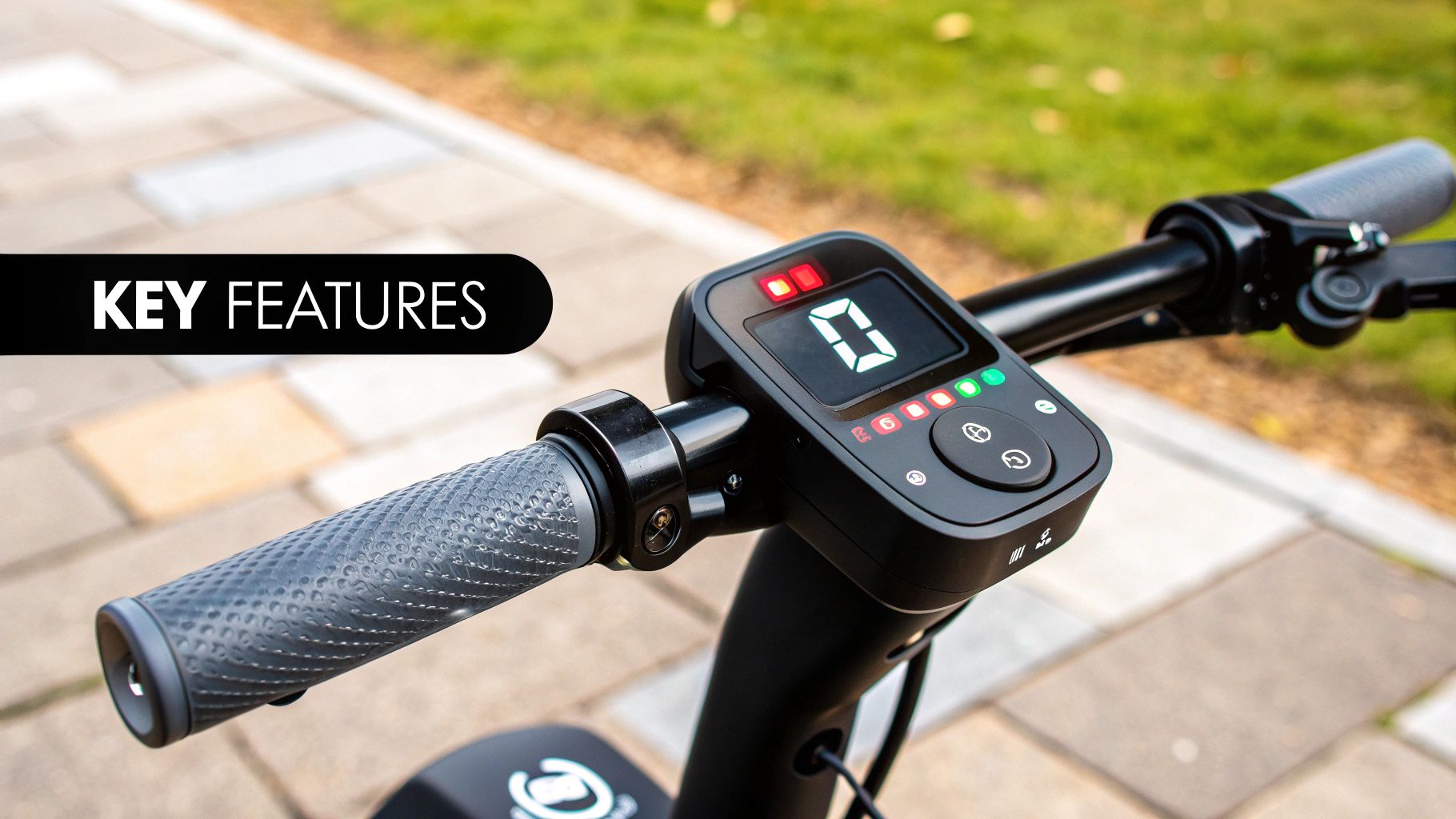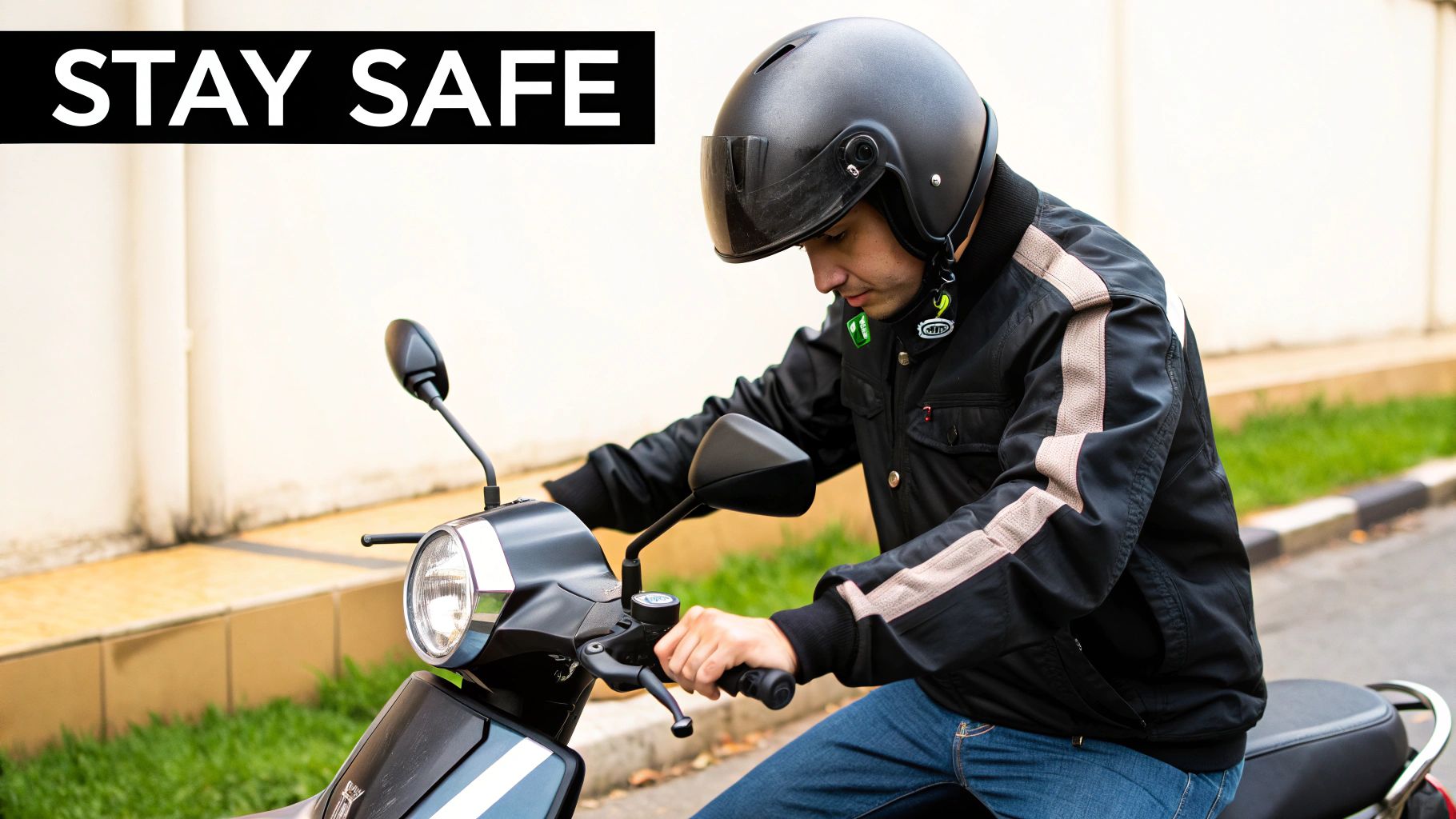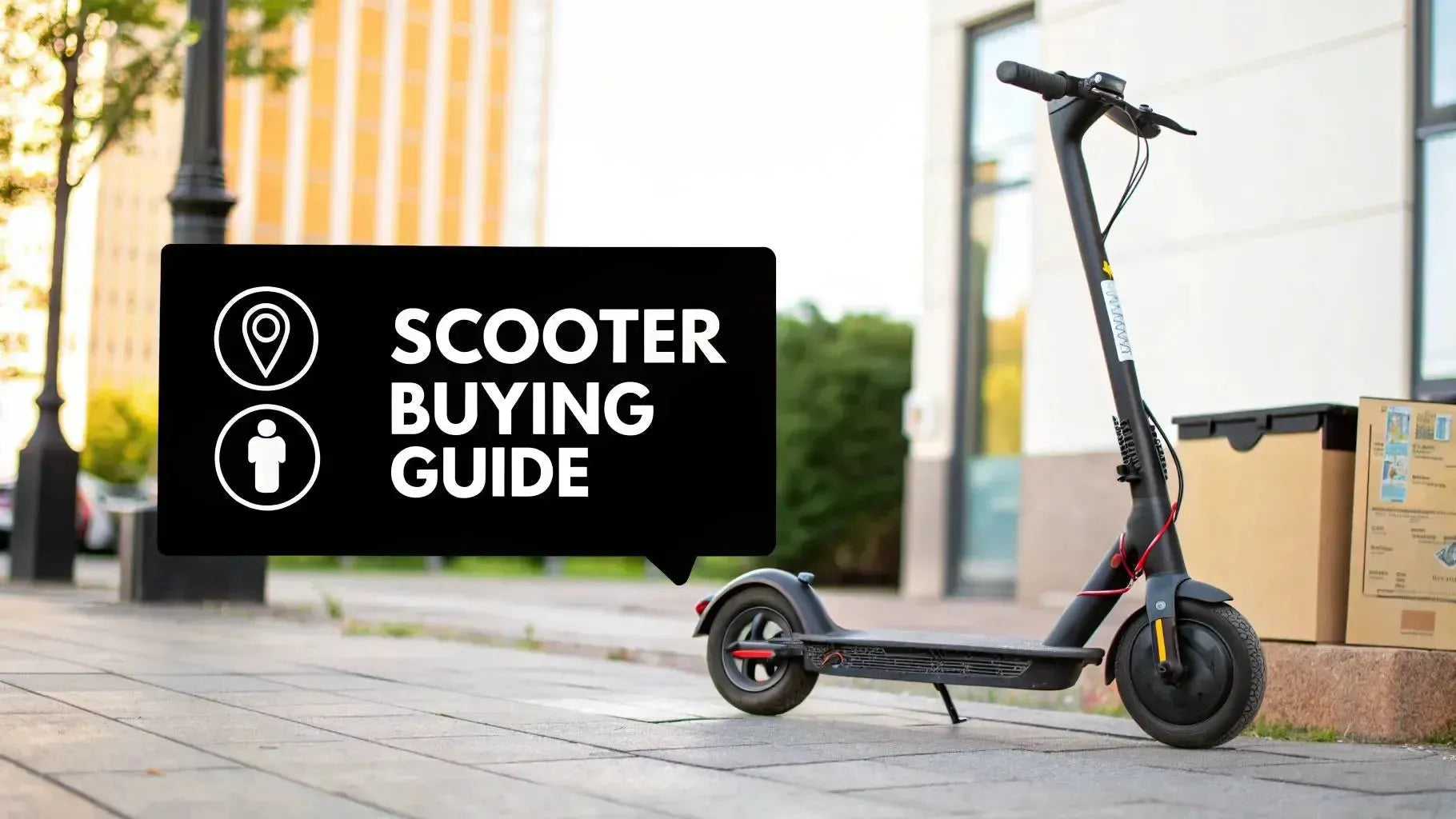So, you're thinking about getting an electric scooter? Smart move. Welcome to a whole new way of getting around town. As cities across Australia, the US, and the world get smarter about travel, hopping on a scooter is one of the best ways to beat the traffic and actually enjoy your commute. This guide is here to be your friendly co-pilot, cutting through the confusing tech specs so you can find the perfect ride.
Finding Your Ideal Electric Ride
Picking your first electric scooter can feel a bit like staring at a massive wall of options. Don't sweat it. The trick is to think of it less like buying a high-tech gadget and more like choosing the right pair of shoes—it all comes down to what you'll be doing with them.
Are you looking for something light and zippy for that last mile to the train station? Or do you need a tougher, long-range machine for weekend exploring? We'll help you zero in on what really matters for your journey.
There's a reason you're seeing so many scooters on the streets. This isn't just a fad; it's a real change in how we move through our cities. The global market is expected to rocket from USD 38.4 billion in 2025 to a massive USD 91.1 billion by 2035. That's a whole lot of people ditching their old commutes, and you can get the full scoop on this trend in this detailed market analysis.
Starting Your Search the Smart Way
Before we get into the nitty-gritty of motors and batteries, let's take a step back. The absolute best way to start is to think about your daily reality. A scooter that's perfect for a 15-minute glide across flat pavement is going to be wildly different from one built to conquer steep hills on a long-distance trip.
To make this super simple, the table below breaks down the most important things to think about.
Think of this as your pre-flight checklist. Figure out what's a 'must-have' versus a 'nice-to-have' right now, and you'll sail through the rest of this guide. It's the best way to make sure you don't get distracted by flashy features you'll never actually use.
Let's start by laying out the big-picture items. Use this summary to quickly identify your priorities and understand the key trade-offs when choosing an electric scooter.
Quick-Glance Scooter Buying Checklist
| Key Factor | What It Means For You | Top Priority For... |
|---|---|---|
| Budget | How much you're willing to spend. Higher prices usually mean better range, power, and build quality. | Everyone! But especially first-time buyers and those on a tight budget. |
| Range | The maximum distance the scooter can travel on a single charge. Real-world range is often less than advertised. | Long-distance commuters or anyone who doesn't want to charge their scooter daily. |
| Motor Power | Measured in watts (W), this determines acceleration and hill-climbing ability. More power = more fun (and easier hills). | Riders in hilly areas, heavier individuals, or those who crave quick acceleration. |
| Build Quality & Durability | The quality of the frame, components, and water resistance rating. A solid build means a safer, longer-lasting ride. | Daily commuters, riders in wet climates, or anyone who wants a scooter that will last for years. |
| Portability & Weight | How much the scooter weighs and how easily it folds. A heavy scooter is a pain to carry up stairs or onto public transport. | "Last-mile" commuters who use trains/buses, or people living in apartments with no ground-floor storage. |
| Use Case | Are you commuting, running errands, or just having fun? Your primary use will dictate all other choices. | Absolutely everyone. This is the first question you should answer. |
This little exercise will give you a clear direction as we dive into the details. Now that you've got your priorities straight, let's find the scooter that will completely change the way you get from A to B.
Making Sense of Scooter Tech Specs
Jumping into the world of electric scooters can feel a bit like learning a new language. You’re bombarded with terms like "watts," "amp-hours," and "suspension," but what does any of that actually mean for your ride? Let's cut through the jargon and translate these specs into real-world performance you can actually feel.
Think of an electric scooter's motor as its engine. Measured in watts (W), this number tells you just how much muscle it has. A lower wattage, say around 250W, is your dependable city cruiser. It’s perfect for gliding along flat urban streets and handling gentle slopes with ease.
But what if your daily route includes some serious hills, or you're a heavier rider? That’s when you need to step up the power. A scooter with a 500W motor or more is like an SUV—it has the extra oomph to tackle inclines without slowing to a crawl. For true thrill-seekers, motors can go all the way up to 1000W and beyond, delivering neck-snapping acceleration and the power to conquer pretty much any hill you throw at it.
Matching Motor Power to Your Ride
Not sure how much power you really need? This table breaks down what those wattage numbers mean for your day-to-day.
| Motor Power (Watts) | Best For | Hill Climbing Ability | Typical Use Case |
|---|---|---|---|
| 250W-350W | Flat city commutes, lightweight riders | Handles gentle slopes, struggles with steep hills. | Compliant with many regional e-bike laws. |
| 500W-750W | Hilly areas, heavier riders, more zip | Climbs moderate hills confidently. | A great all-rounder for performance. |
| 1000W+ | Performance enthusiasts, off-road riding | Powers up steep inclines without breaking a sweat. | Often for private land or off-road use. |
Ultimately, a bigger motor gives you more torque for hills and quicker acceleration, but always be sure to check your local regulations before you buy.
Powering Your Journey: The Battery Explained
If the motor is the engine, the battery is the fuel tank. Its capacity is what dictates your range—how far you can go before needing to plug in. When you look at battery specs, you’ll see two main numbers: voltage (V) and amp-hours (Ah).
Here's an easy way to think about it: voltage is like the pressure in a hose, while amp-hours represent how much water is in the tank. Higher voltage pushes power to the motor more efficiently, and more amp-hours means the battery stores more energy. These two figures combine to give you the total capacity, measured in watt-hours (Wh). A bigger tank simply means more miles.
The crucial takeaway is this: a larger battery (higher Ah and Wh) will almost always give you a longer real-world range. Don't just look at the manufacturer's maximum range claim; look at the battery specs to get a truer picture of its endurance.
Today, nearly all good scooters use lithium-ion (Li-ion) batteries. They've almost completely replaced the old, heavy lead-acid types because they're lighter, last longer, and pack more power, which translates directly to a better ride.
This image gives you a great visual of how different scooter types are built for different needs, which often comes down to their core tech specs.

As you can see, a lightweight commuter scooter will have very different specs from a beefy, all-terrain beast. It's all about matching the hardware to the job.
Smooth and Safe: Stopping Power
Alright, we’ve covered going and lasting—now let's talk about stopping. Your brakes are, without a doubt, the most critical safety feature on your scooter. You'll generally come across three main types:
- Disc Brakes: These are the best of the best. Just like on a car or high-end bike, they offer fantastic stopping power in both wet and dry weather. They are the gold standard for a reason.
- Drum Brakes: Tucked away inside the wheel hub, drum brakes are super low-maintenance and protected from grime. They might not have the raw bite of disc brakes, but they are a solid, reliable choice for city riding.
- Electric/Regenerative Brakes: These use the motor's resistance to slow you down, and they even put a tiny bit of charge back into your battery. They’re great for gentle braking but are always paired with a mechanical brake (disc or drum) for real stopping power.
For anyone riding on unpredictable city streets, I always recommend a setup with at least one disc brake. It just gives you that extra confidence when you need it most. To see how these features vary across models, you can compare electric scooter specifications side-by-side right here on our site.
The Quest for a Comfortable Ride
Last but not least, let's talk comfort. A scooter's ride quality comes down to two things: its tyres and its suspension. This is a huge deal, especially on the less-than-perfect roads we often see in cities around the world.
You’ve got two main choices for tyres:
- Pneumatic (Air-Filled) Tyres: These are just like bike tyres and are the kings of comfort. They naturally soak up bumps and vibrations, giving you a wonderfully smooth ride. The only catch? They can get punctures.
- Solid Tyres: Made of solid rubber, these are completely puncture-proof, which is a massive plus. The trade-off is a much harsher, bumpier ride, as they don't have any give to absorb road chatter.
To really smooth things out, many scooters add a suspension system. This can be anything from a simple spring on the front wheel to a sophisticated dual-spring or hydraulic system on both. When you combine good suspension with air-filled tyres, you get the smoothest ride possible—something that makes a world of difference on a long commute or over rough ground.
Finding a Scooter That Fits Your Lifestyle

Here’s a little secret: there's no such thing as the "best" electric scooter. It just doesn't exist. What does exist is the best scooter for you. Figuring out how you'll actually use your scooter is the most important part of this whole process. It's what turns a confusing jumble of specs into a clear, simple shopping list.
So, before you dive into motor watts and battery stats, just ask yourself one thing: what kind of rider am I? Answering that question will help you filter out all the noise and focus on what truly matters for your daily trips.
Let's look at the most common types of riders and see which one sounds like you.
The Last-Mile Commuter
Do you mix and match your transport? Maybe you jump on a train for the long haul and need something to zip you from the station to your office. If that's you, you're a Last-Mile Commuter, and your world revolves around one thing: portability.
Your perfect scooter is light, compact, and easy to handle when you're not riding it. It needs to be something you can carry up a flight of stairs without cursing or fold in a flash to slide under a train seat. Trust me, anything over 15kg (about 33 lbs) starts to feel like a workout pretty quickly.
For this kind of rider, you'll want to look for:
- Low Weight: Aim for models under the 15kg mark. Your back will thank you.
- A Solid Folding System: You need something that clips together quickly and securely. No fumbling around on a busy platform.
- Modest Range: You don't need a monster battery for short hops, which is great because it keeps the scooter's weight down.
You can easily get by with less power and a lower top speed. The goal here isn't to break speed records; it's to make that last part of your journey totally seamless.
The Urban Explorer
Maybe you see a scooter as your main way to get around the city. You're the Urban Explorer—someone who wants the freedom to cruise through town, run errands, or take the scenic route home from work. Your journeys are longer, and you need a scooter that can keep up.
For you, it's all about comfort and range. You’ll need a scooter with a beefier battery to give you enough juice so you're not constantly worried about running flat. A flimsy, ultra-lightweight model just won't feel right on bumpy city streets.
As an Urban Explorer, you're looking for a great all-rounder. It needs to be tough enough for daily rides and comfortable enough for longer trips, but not so heavy that you can't carry it up to your flat.
Your shopping list should prioritise:
- Serious Range: Look for scooters with a real-world range of 20+ miles (32+ km).
- Comfort is Key: Pneumatic (air-filled) tyres and some form of suspension are a must for smoothing out those less-than-perfect city pavements.
- A Sturdy Build: A solid frame and good brakes give you the confidence you need when navigating unpredictable traffic.
The Power User
And finally, we have the Power User. You might live somewhere with serious hills, have a super long commute, or you just love the feeling of having a bit of extra oomph under your feet. Your scooter isn't a toy; it's a serious vehicle.
For you, performance is everything. You're looking for a beast with a powerful motor (or maybe even two!) to tackle steep inclines without breaking a sweat. A massive battery is non-negotiable for those long-distance rides, and top-tier features like advanced suspension and powerful disc brakes are essential for safety when you're moving at speed.
These high-performance scooters are the heavyweights, and they definitely sacrifice portability for pure power. But if you need a machine that can genuinely replace a car for your daily travels, this is where you should be looking. By figuring out your rider profile first, you can skip the guesswork and find a scooter that feels like it was made just for you.
Build Quality and Safety: The Stuff That Really Matters
It’s easy to get fixated on top speed and how many miles you can squeeze out of a single charge. But honestly, the real secret to a scooter you’ll love for years is how well it's put together. The frame, tyres, and safety features are the unsung heroes of every ride, dictating not just longevity, but your comfort and safety too.
Think of the frame as the scooter's backbone. The best ones are usually built from aerospace-grade aluminum, which hits that sweet spot between being tough as nails and light enough to carry. You want something that can take a beating on city streets without feeling like you're lugging a dead weight up the stairs to your flat.
It's the little things that often scream quality. Are the cables managed cleanly, or are they a rat's nest? Does the folding mechanism lock into place with a satisfying click, or does it feel wobbly? These details are a dead giveaway of how much care went into the design and manufacturing.
Can It Handle a Bit of Rain?
Let’s face it, no matter where you live, you’re eventually going to encounter some wet weather. That’s why IP ratings (Ingress Protection) aren’t just jargon; they're essential. This little two-digit number tells you exactly how sealed the scooter's delicate electronics are from dust and water.
A rating of IP54 is a pretty standard starting point. The first number (5) tells you it's got good dust protection, and the second (4) means it can handle splashes from any direction. It’s enough to give you peace of mind if a light shower starts on your way home.
A higher rating like IPX6 or IPX7 offers a lot more protection against water, but don't get carried away—no electric scooter is a submarine. It’s always smart to avoid riding through massive puddles or in a proper downpour.
The Great Tyre Debate: Air-Filled vs. Solid
Your tyres are the only part of the scooter that actually touches the ground, so this choice has a massive impact on how your ride feels. It’s probably one of the biggest forks in the road when picking a scooter.
You've got two main camps, each with some serious pros and cons:
- Pneumatic (Air-Filled) Tyres: These are the kings of comfort. Just like on a bike, the air inside acts as natural suspension, smoothing out cracked pavement and bumpy roads. The ride is just buttery smooth. The only catch? You can get a puncture.
- Solid Tyres: Made of solid rubber or filled with foam, these things are invincible. Puncture-proof, zero-maintenance bliss. The trade-off, however, is a much rougher ride. You'll feel every single bump and crack in the road.
For most people navigating city streets, the cushy ride from pneumatic tyres is well worth the small risk of a flat. The difference in comfort is night and day.
Your Safety Non-Negotiables
When you're zipping around town, the gear that keeps you safe isn't optional—it's everything. These are the features that help you stay in control and visible to everyone else on the road.
First and foremost: brakes. As we've mentioned, disc brakes are the gold standard for a reason. They give you the stopping power you need to react quickly and confidently. A good set of brakes is your number one safety tool, so don't skimp here.
Next up, you have to see and be seen. Any decent scooter should have bright, integrated LED lights. A powerful headlight is a must for lighting up your path, and a rear light (that often gets brighter when you brake) is crucial for letting people behind you know what you’re doing. Good visibility is key, especially for early morning or evening rides.
Finally, what about when you park? A shiny new scooter is a tempting target for thieves. A high-quality lock is just as vital as the scooter itself. If you need some pointers, you can learn how to lock your electric scooter properly to make sure it's waiting for you when you get back.
So, you're excited about getting an electric scooter. I get it. But before you get carried away with specs and models, we need to talk about something a bit less thrilling but way more important: the law.
Figuring out the rules of the road for e-scooters in Australia and the US can feel like navigating a maze. It’s a mix of different state and local regulations, and getting it wrong can land you in hot water. Let's clear up the confusion.
Navigating Electric Scooter Laws in Australia and the US
The USA: A State-by-State Puzzle
In the United States, there is no single federal law governing electric scooters. Instead, it's up to each individual state—and sometimes even city—to set its own rules. This creates a real patchwork of regulations.
For example, California has specific laws that treat e-scooters similarly to bicycles, requiring helmets for minors and restricting them from sidewalks. Meanwhile, other states might have very few rules, or classify them as mopeds, bringing in a whole new set of requirements for registration and licensing. The situation is constantly evolving as scooters become more popular.
Australia: Rules Vary by Territory
Down Under, the situation is similar. Australia doesn't have a national law for personal e-scooters; it's handled at the state and territory level. This means the rules in Queensland are completely different from those in New South Wales or Victoria.
Some states, like Queensland, have embraced them with clear guidelines on speed limits (usually 25 km/h) and where you can ride. Other states have been much slower to adapt, with heavy restrictions on where privately owned scooters can be used. Rental trial schemes are common in many cities, which are helping to shape future legislation.
Here's the bottom line: Never assume the rules are the same everywhere. A quick Google search for the "e-scooter laws" in your specific state, territory, or city will save you a world of trouble and keep you on the right side of the law.
Common Rules to Watch For
Even with all the differences, some common themes pop up in most places where e-scooters are legal. Keep these in mind, and you’ll be ahead of the game.
- Speed Limits: Most places cap the speed at around 15-20 mph (25-32 km/h). This seems to be the sweet spot for letting scooters mix safely with other traffic and bikes.
- Where to Ride: You're generally good to go in bike lanes and on the road (often in lanes with lower speed limits). Sidewalks are frequently a no-go zone to keep pedestrians safe.
- Helmets & Age Limits: Helmet laws vary wildly, but it's always a smart idea to wear one regardless. Minimum age requirements are also common, typically kicking in at 16.
- Motor Power: Some jurisdictions have limits on motor wattage to distinguish scooters from more powerful vehicles, but this is less common in the US and Australia than in Europe.
Before you hit that “buy” button, spend five minutes looking up the local rules. It's a tiny bit of effort that ensures your new scooter is all about freedom and fun, not fines and frustration.
Your Essential Scooter Maintenance Checklist

So, you’ve picked out the perfect electric scooter. Awesome! Now for the easy part that makes a huge difference: a little bit of upkeep. Don't worry, proper maintenance isn't a chore. But it is the secret to keeping your ride smooth, safe, and running like new for years.
Think of it just like a bicycle. A few quick checks before you head out can save you from a major headache later on. This isn't just about getting the best performance; it’s about feeling confident and safe every single time you ride. A scooter you take care of is a scooter you can trust.
Let's run through a simple checklist that will quickly become second nature.
Pre-Ride Checks: The 5-Minute Safety Scan
Before you hop on, make a habit of giving your scooter a quick once-over. This little scan is your best defence against any surprises and makes sure every trip starts off right.
Here’s what to eyeball:
- Tyre Pressure: Got air-filled tyres? Give them a firm squeeze. Properly inflated tyres give you better grip, a comfier ride, and are way less likely to get a puncture. Honestly, under-inflated tyres are the number one cause of a miserable ride.
- Brake Check: Pull the brake levers. Do they feel solid and responsive? They shouldn't feel mushy or loose. Just roll the scooter forward a foot and hit the brakes to make sure they have enough stopping power.
- Lights & Controls: Flick your lights on. You need that front and rear light working, especially for rides at dawn, dusk, or after dark.
These steps take less time than brewing a coffee, but they’re massively important. Knowing when you might need an electric scooter tyre replacement is the kind of thing that can keep you out of trouble.
Getting the Most Out of Your Battery
The battery is the heart of your scooter, and a little TLC is all it needs to live a long, happy life. Bad charging habits can seriously shorten its lifespan and cut down your range, so a few smart practices will pay off big time.
Key takeaway: Don't treat your scooter battery like your phone. Running it flat to 0% or leaving it plugged in at 100% for days puts stress on the cells. The happy place for long-term battery health is keeping it between 20% and 80% charge as much as you can.
Stick to these golden rules for battery care:
- Avoid Extreme Temps: Never, ever charge your scooter when it's freezing cold or right after a long ride when the battery is hot. Let it get back to room temperature first.
- Use the Right Charger: Stick with the charger that came in the box. A cheap third-party one might not have the right voltage or safety cutoffs, which is a recipe for disaster.
- Charge After Your Ride: It's generally better to top up the battery when you get home instead of letting it sit empty for days on end.
Keeping It Clean and Safe
A clean scooter is a happy scooter. Seriously. Wiping down the frame, deck, and wheels with a damp cloth doesn't just make it look good—it gives you a chance to spot any loose bolts, tiny cracks, or other potential problems before they get worse.
This idea of proactive care is a big deal. For instance, large rental fleets are now using artificial intelligence (AI) to predict when a scooter needs maintenance before it breaks down. It just goes to show how important a little foresight is, whether it comes from a smart algorithm or just you with a cloth and a sharp eye.
Got Questions About Electric Scooters? We’ve Got Answers.
Alright, let's tackle some of the most common questions we hear from people who are new to the electric scooter scene. Think of this as the final pit stop in your buying journey, where we clear up those last few lingering thoughts.
How Much Should I Actually Spend on an Electric Scooter?
This is the big one, right? For your first scooter, a solid starting budget is somewhere between $350 and $600. In this sweet spot, you’ll find reliable scooters from good brands that are perfect for shorter commutes or just cruising around town.
If you know you’ll be riding longer distances or want a smoother experience with features like suspension, you’ll probably want to look in the $600 to $1,000 range. For the real enthusiasts who crave speed and power, high-performance models with dual motors and massive batteries can easily top $1,200. Our advice? It's almost always worth spending a little extra for a brand you can trust. It pays off in build quality and customer support down the road.
What’s a Realistic Range for an Electric Scooter?
This is where things can get tricky. The range you see advertised on the box is usually based on perfect, fantasy-land conditions: a super light rider, perfectly flat ground, no wind, and the scooter chugging along in its slowest eco mode.
A good rule of thumb for a real-world estimate? Take the advertised range and knock off about 30-40%. So if a scooter claims it can go 25 miles, you should plan on getting more like 15-18 miles on a normal day with a few hills and regular stops.
Should I Get Air-Filled Tyres or Solid Tyres?
This really boils down to what you value more: comfort or convenience. There’s no single right answer, just a choice.
- Air-filled (pneumatic) tyres are the kings of comfort. They act like mini shock absorbers, soaking up all the bumps and cracks in the road for a noticeably smoother ride. The catch? Just like a bike tyre, they can get a puncture.
- Solid tyres are the definition of low-maintenance. They are completely puncture-proof, so you'll never have to worry about getting a flat. The trade-off is a much harsher, bumpier ride where you feel every single imperfection on the pavement.
For most riders navigating typical city streets in Australia or the US, the cushy ride you get from pneumatic tyres usually wins out.
Ready to find a ride that fits you perfectly? Check out the handpicked selection of top-notch electric scooters and bikes over at Punk Ride LLC. We only stock brands we trust to get you where you need to go.





Share:
How to Compare Electric Scooter Models
Best Electric Scooters For Adults